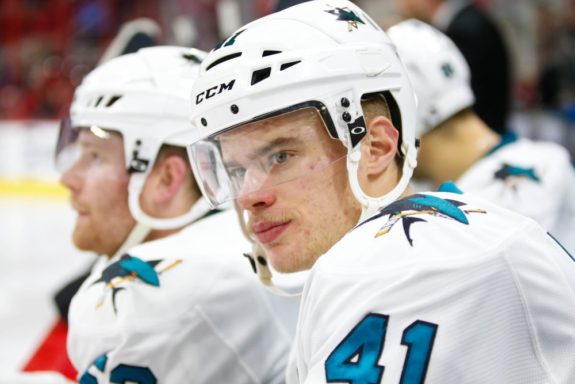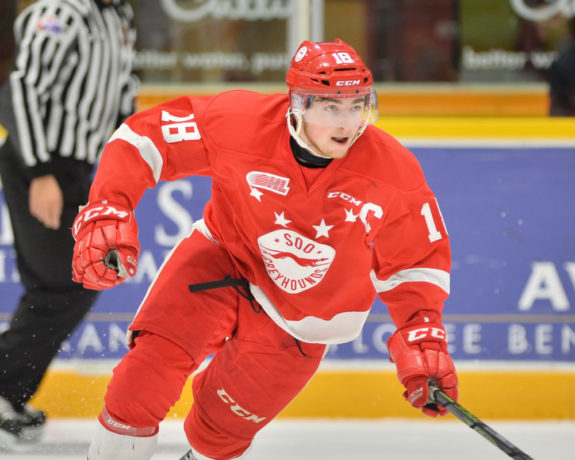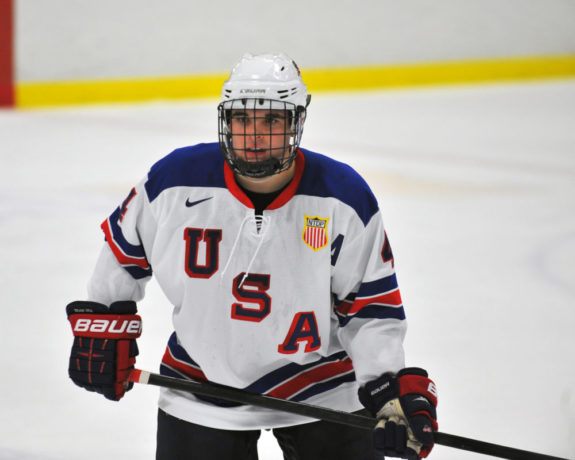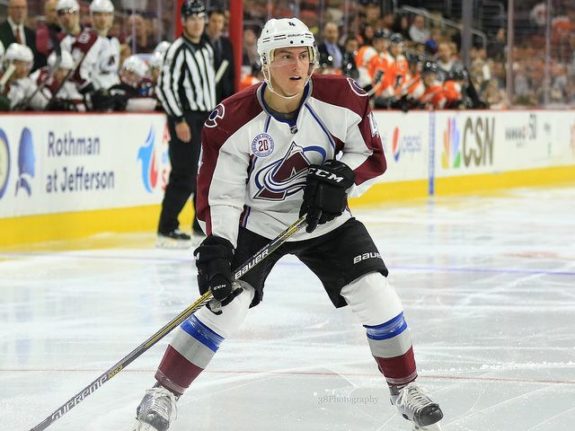Despite all of the good press they have received lately, the New Jersey Devils’ roster needs more to propel the team to their first playoff appearance in six years. The forward corps looks mostly complete – with a few points of weakness – but the defense is in dire need of help. The challenge for general manager Ray Shero will be addressing these needs in some fashion before the season starts.
Roster Assessment
In order to understand the team’s needs, it is imperative to assess the current roster to see where openings and deficiencies exist. Right now, the Devils roster looks as good as it has since Shero stepped in, but still could use some work. Starting with the forwards, it is easy to pinpoint where the notable vacancies are.
Forwards
There are a few players whose positions and roles with the team are pretty much set in stone: Taylor Hall, Travis Zajac and Kyle Palmieri are top-six left wing, center and right wing, respectively. Marcus Johansson and Adam Henrique slot in as middle-six left wing and center, respectively. Of course, there is new forward signing Brian Boyle and first overall selection Nico Hischier, who both figure to be top-nine options for the Devils next year. Figuring that 2016-17 fixtures like Miles Wood, Pavel Zacha, Nick Lappin and John Quenneville return to their roles from last year, center and left wing contingencies appear fulfilled. The lineup would look something like this:
Taylor Hall – Travis Zajac – Kyle Palmieri
Marcus Johansson – Adam Henrique – Nico Hischier
John Quenneville – Pavel Zacha – 3rd Line Right Wing
Miles Wood – Brian Boyle – Nick Lappin

Notice that Hischier is not at his natural center position in this lineup. He will likely make it to New Jersey, but it is unclear where he would play given that head coach John Hynes has said that he expects the Swiss forward to start his career at center, not right wing (his secondary position). Despite Hynes’ wishes, there may be no choice since Hischier is unlikely to outplay any of the four centers above as he settles at the NHL level. Thus, I will assume that he takes on right wing, the position where he is most needed.
The best part of this lineup is that there is so much potential for more. Zacha was a good third line center last year at 19 years old; he could very well make the jump to being a top-six talent this season. Quenneville was making plays every which way in 2016-17 and could become a versatile middle-six forward for New Jersey.
Perhaps the only knock on this lineup is Zajac at first line center. Forty-five points does not make a first line center, so anybody who advocates this placement is hoping that Zajac can continue to re-establish himself as a playmaking center. Of course, Zajac is also great on the faceoff dot and one of the best two-way centers in the NHL. That said, the reality is that the only centers who can do that and look good on a first line are Jonathan Toews, Anze Kopitar and Patrice Bergeron.
Defense
On defense, the team has numbers, but they are lacking in the skill department. Andy Greene, John Moore and Damon Severson would be top-four defenders on most teams, but they would play almost exclusively on the second pairing. Instead, two of those defenders will likely take on 22-plus minutes a night against top-end competition.
The last three spots will be open for battle among Steve Santini, Mirco Mueller, Ben Lovejoy, Dalton Prout, Michael Kapla and Yaroslav Dyblenko. Again, numbers are not the problem here, but rather talent. Lovejoy proved that he cannot offer anything on offense and his defensive game worsened as the season progressed. Prout has proven in his time with Columbus that he cannot handle many minutes at all, mostly useful for his sandpaper style of play. Santini and Mueller are both unproven – who knows if either will succeed in the NHL at just 22 years old? Kapla is a recent NCAA signing who likely needs more seasoning in the AHL. The same story goes for Dyblenko.

That leaves the team with the following lineup:
Andy Greene – Damon Severson
John Moore – Steven Santini
Mirco Mueller – Ben Lovejoy
It is not exactly an inspiring sight, as just about every defender is playing above their current talent level. That being the case, it will very much be sink or swim for the Devils’ defense in 2017-18 unless they can find help soon.
Having looked at both the offense and defense – the goaltending situation is completely fine, by the way – it is now time to identify team needs. In this case, there are three that jump out: a top-nine scoring right wing, a top-four two-way left defenseman, and a veteran middle-pairing right defenseman.
Need #1: Top-Nine Right Wing
As mentioned, the Devils forward corps has seen its fair share of praises lately. But at one specific position, the team comes up just short. That position is right wing. The Devils currently have just Kyle Palmieri and Nick Lappin as natural right wings. This is not to say that players like Michael McLeod, Quenneville, or even newcomer Marcus Johansson cannot handle the right flank, but effective roster management includes playing each skater at his best position.
Moreover, the Devils have an imbalance of left-handed shooters as opposed to right-handed ones. This prevents the team from diversifying its strengths and plays a role in line chemistry. Using the roster above, there are just three right-handed shots to eight lefties.
In all likelihood, this vacancy can be filled from within. The team has two great right-handed prospects, one OHL graduate and one who has proven himself in the OHL over the years: Blake Speers and McLeod, respectively.

Speers was a center and right wing for the Sault Ste. Marie Greyhounds of the OHL. He was strong in the faceoff circle, aggressive on the forecheck, but also possesses a nice shot. At the time of his drafting, many suspected he would end up a tertiary scorer at best. However, if his current resume is any indication, Speers could adequately fit in a team’s top-nine right now. In 2016-17, he scored 34 points in 30 games, once again captaining Soo to the playoffs.
The second candidate, McLeod, is likely to be a center at the NHL level and has played almost exclusively in the middle over the years. He’s lightning quick, talented with the puck, and has a budding two-way presence. Whereas Speers has a good shot that makes him dangerous coming in on the wing, McLeod is a far better passer and would likely form a great trio with Quenneville and Zacha, both of whom can also finish. That said, McLeod is less likely to get an extended opportunity this year because of his current contract: he is not AHL eligible in 2017-18, meaning that if he runs cold, the Devils will either have to keep him in New Jersey or send him back to Mississauga. That can harm a prospect’s development rather significantly, and the Devils are no stranger to it (Stefan Matteau is a heinous example of this).
Need #2: Top-Four Left Defenseman
In reality, the Devils are in greater need of a top-two left defenseman than a top-four one, as the former would be able to push Andy Greene down a pairing to his rightful place. However, it is far too late in the offseason to find that sort of talent. The only available defenseman even close to being a top-two defenseman was Andrei Markov, but he recently bolted for the KHL after lack of interest in the NHL.

The Devils currently have complicated matters to sort through on the left side of the defense. Greene is the team’s captain and still the top rearguard; Moore led the blue-line in goals last season and could become the 30-point defender on the left side that the Devils covet. Mueller is likely not ready for 16-18 minutes a night except in highly sheltered situations, but he is the team’s next best LD. By all indications he seems to have the faith of the entire front office, being acquired for a second- and fourth-round pick and being re-signed to a two-year contract.
Despite what seems like a complex situation, the Devils would be well suited to have an insurance policy in case Greene’s ironman-like durability begins to suffer in the twilight years of his career. When Greene missed time last year, Jon Merrill jumped in and performed adequately, but he was taken by Vegas in the Expansion Draft.
It will likely take a PTO or late free agency signing to improve the left side of the defense. Fortunately, the Devils have a great opportunity to resolve this on Aug. 15, when all unsigned NCAA graduates become unrestricted free agents. Headlining that list are two players: first, the Devils’ Alex Kerfoot, who graduated from Harvard in May and presumably does not want to be a Devil. The second, and more talented player, is Will Butcher of Denver, the 2017 Hobey Baker winner as the NCAA’s top player.
Butcher would be great for the Devils; he’s a former captain for the Denver Pioneers, a left shot, and strong on the powerplay. Failing that, there are a few talented players who could, much like Kyle Quincey did for the Devils in 2016-17, step in and play a minor role on the defense. Names like Dennis Wideman and Francois Beauchemin come to mind.

Need #3: Middle-Pairing Right Defenseman
First, there is a difference between a top-four and middle pairing defenseman. The former implies a No. 1, 2, 3, or 4 defenseman, whereas the latter asks for a No. 3 or 4 (although a No. 2 or 5 could play that role without problem). In this case, the Devils need the latter more so than the former.
The right side of the Devils’ defense is not in great shape. Severson is clearly a top-four guy right now, but Lovejoy and Prout are arguably not suited for a full-time role anymore. Santini may be better suited rounding out his offensive game in Binghamton before returning to New Jersey in a full-time capacity. A middle pairing blue-liner would push Lovejoy, Santini, and Prout down a peg, providing greater depth for the defense.
There seem to be two names thrown around most often nowadays, the Avalanche’s Tyson Barrie and the Ducks’ Sami Vatanen. The former has been rumored to be available for almost a year, with his 2016 performance, 49 points in 78 games, being a big reason why. He’s crafty with the puck and is able to set up close to goal for his teammates. Despite being short, Barrie packs a wallop in his shot and could very well be a top-puck mover for teams. And, with due respect to two opinions saying otherwise, he should not be on the Devils’ radar as much of his calling is already performed by Severson.

Vatanen, on the other hand, would be a welcome addition to New Jersey. Rumored to be a trade target of the Devils in May, Vatanen has fallen out of favor in Anaheim mostly for monetary reasons; Hampus Lindholm and Cam Fowler both signed massive contracts in recent years, meaning the team no longer is able to pay for all three. Vatanen is also a puck-mover, like Barrie, but offers just a bit more on the defensive side, helping him to provide some stability on the right side. The Due to salary cap issues, the Ducks may be forced to sell him at a discount in the near future.
Another name that could be had for cheap is Cody Franson. He may still be jobless come September, at which point he could come in on a professional tryout (PTO) much like Kyle Quincey and David Schlemko have done in the last two years.